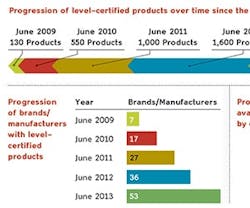In the world of eco-labels, some are more comprehensive than others. In the world of big business, some companies are, let’s say, more cooperative than others. When those two forces combine, consumers stand to reap the benefits.
That’s the case with both the ANSI/BIFMA e3 Furniture Sustainability Standard and the level® third-party certification program, which have streamlined the process for evaluating furnishings produced in increasingly sustainable ways.
After almost three years in development, the Furniture Sustainability Standard (e3) was born in 2008 as members of the Business and Institutional Furniture Manufacturers Association (BIFMA) and other stakeholders came together to meet a growing market demand for furniture with environmental and socially responsible attributes. One year later, the group launched level, one of the most open and transparent means of evaluating and communicating the environmental and social impacts of furniture products in the built environment.
The program quickly became a hit within the A&D community, which, in turn, urged manufacturers to adopt it on an incredible scale. As of this deadline, specifiers can select from more than 4,700 products in 47 categories and subcategories that have been evaluated against the sustainability standard and granted a level 1, 2 or 3 (with 3 being the highest) certification mark. However, level’s success in the marketplace is about more than just the numbers; it is built upon three key features that make it unique in an industry filled with competing certification programs.
multi-attribute
What the contract furniture industry did to create e3 and level was no small feat. Only one in 10 industries have a third-party eco-label or mark; fewer than that have created a multi-attribute sustainability standard. Indeed, most certifications today address a single aspect of sustainability, such as product emissions, energy utilization or the use of certified wood.
At the time that BIFMA started its work on a sustainability standard, its customers were being bombarded with the proliferation of single-attribute certifications, many of which competed with one another in the same category. To lessen the confusion, BIFMA took a more holistic approach to sustainability, accounting for a wide range of product attributes that includes material composition, recycled content, chemicals, human health and ecosystem impacts and many others.
The result is a reputable, comprehensive and easy-to-understand rating that makes it simple for specifiers to identify the most sustainable furnishings on the market.
third-party
The office furniture industry chose to design level as a third-party certification program, which is a more trusted form of environmental conformance verification.
In order for a furniture product to receive the level certification and mark, a manufacturer must contract with a recognized independent, third-party certification body. Intertek, NSF International, Orion Registrar, Inc., SCS Global Services, TÜV Rheinland® LGA Products GmbH and UL Environment are currently approved by the American National Standards Institute (ANSI) to be third-party certifiers of level products.
One of these certification bodies must serve as auditor of the product, production processes and the organization, and will grant the appropriate level 1, 2 or 3 certification for a product based on the number of points received. Of the 91 points available in level, 16 relate to the organization, 38 to the facility and 37 to the product. Products earn level 1 certification for receiving 32-44 points; level 2 for receiving 45-62; and level 3 for anything above 63.
In addition, all companies must meet certain prerequisites such as having formal policies on employee health and safety management, energy and human rights. Many products will move up a tier as they become increasingly more sustainable—typically when new materials or manufacturing processes are implemented.
consensus process
Much like the field of sustainable design, the level program and e3 standard are in a continuous state of improvement. Following the ANSI standards development protocols and consensus process, BIFMA initially involved over 125 participants from inside and outside the industry in the development of the e3 Furniture Sustainability Standard. The association continues to work with the same diverse group of contributors to quickly incorporate new concepts and technologies, such as Life-Cycle Assessments, into e3 and level, ensuring that they remain relevant and cutting-edge tools.
In short, the level program saves time and streamlines the selection of sustainable furniture products by encouraging the values of transparency and cooperation. As time and budgetary pressures continue to grow for designers, programs like level promise to keep sustainability at the forefront without getting in the way.
Lisa C. Young is the head of marketing at BIFMA. She works to generate awareness of the level® sustainability certification program to ensure increasingly sustainable products are utilized in the built environment.
